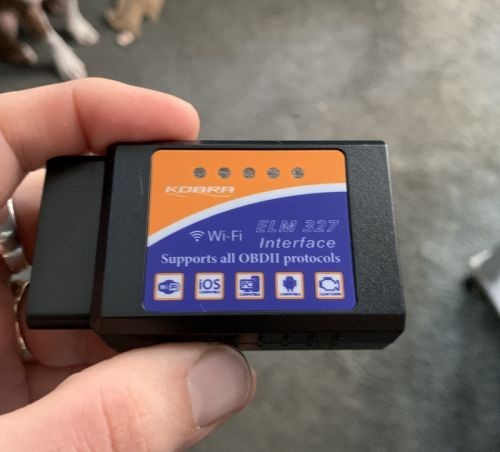That dreaded check engine light – every car owner’s nightmare. When it illuminated on my 2008 vehicle shortly after a recent service, frustration set in. Seeking a DIY solution before heading to the mechanic, I turned to the advice of friends and colleagues: an OBD2 scanner. The idea was to diagnose the issue myself, potentially clear a minor sensor glitch, and avoid unnecessary repair costs. After researching options on Amazon, the Kobra Obd2 Scanner Car Code Reader stood out, boasting over 2700 positive ratings and a claim of a 3000+ code definition database, along with broad vehicle compatibility. For around $20, it seemed like a worthwhile investment to investigate my car’s woes.
Like most OBD2 scanners, the Kobra offers connectivity to your smartphone via either Wi-Fi or Bluetooth to relay diagnostic data from your car. Before diving into the app experience, the first step is locating your car’s OBD-II port. This is typically found under the dashboard on the driver’s side. If you utilize a plug-in device for usage-based car insurance, you’ll need to temporarily disconnect it to connect the Kobra scanner.
Once plugged in, the Kobra OBD2 scanner powers up and is ready to connect to your smartphone. This particular unit uses a Wi-Fi connection. To establish this link, you’ll need to navigate to your phone’s Wi-Fi settings and select the Kobra OBD2 scanner’s network. It’s a straightforward process, similar to connecting to any new Wi-Fi network.
The Kobra OBD2 scanner, advertised as an ELM327 WIFI Scanner and Car Scan Tool, claims compatibility with all car models manufactured between 1996 and 2016, retrieving both generic and manufacturer-specific Diagnostic Trouble Codes (DTCs). While I only tested it on my 2008 model, the 2016 cut-off year is noteworthy and might be a limitation for owners of newer vehicles. The product description also lists a wide array of compatible mobile apps, including popular choices like OBD Fusion, DashCommand, Torque, OBD Link, ScanMaster Lite, and OBD Car Doctor, available on both Apple App Store and Google Play Store. However, my experience revealed a discrepancy between these claims and reality.
My attempt to use the Kobra OBD2 scanner with various OBD2 apps proved challenging. Many apps are designed to exclusively function with their proprietary OBD2 scanners, failing to recognize or connect to the Kobra device. Apps like Garage Pro, FIXD, AutoDoctor, and Torque, among others, did not work for me. Ultimately, I found success only with the Car Scanner ELM ODB-2 app on iOS. While other apps might be compatible, it’s important to note that most commonly favor Bluetooth-connected OBD2 scanners over Wi-Fi, like the Kobra.
The Car Scanner ELM ODB-2 app thankfully offered a Wi-Fi connection option, unlike many others that default to Bluetooth. The default IP address and port settings worked seamlessly when connected to the Kobra OBD2 Scanner via Wi-Fi.
Once successfully connected via the Car Scanner Pro app, a range of diagnostic features became accessible. These included dashboards for real-time data, live sensor readings, and, crucially, the diagnostic trouble codes I was seeking to understand my check engine light. Before delving into the error codes, let’s explore some of the other valuable dashboards provided.
The app provides real-time monitoring of essential engine parameters such as RPM, vehicle speed, and engine temperature. This live data stream can be insightful for understanding your car’s performance under various driving conditions.
Furthermore, the dashboards offer information on trip metrics, including drive time, fuel consumption rate, and total fuel usage. These features can be useful for tracking fuel efficiency and optimizing driving habits for better mileage.
Another useful dashboard displays real-time voltage readings from your car’s electrical system. Monitoring voltage can help identify potential battery or charging system issues.
Turning back to the primary reason for using the scanner – the check engine light – I accessed the error codes section. The Kobra OBD2 scanner revealed several codes: P2004, P0128, P0522, and P0856. The P0856 code, indicating an “inhibited test,” appeared to be a false reading and not a genuine issue. After performing a code clearing function within the app and restarting the car, I wanted to see which codes would reappear. Unfortunately, the P2004 error, “intake manifold air control actuator stuck open,” persisted. Researching this specific code provided valuable information about its meaning and potential repair costs from various automotive shops.
This newfound knowledge proved empowering. Armed with the error code and estimated repair costs, I could approach auto repair shops with greater confidence. The strategy is to inquire about the issue and their diagnosis without revealing your own scan results initially. This allows you to compare their assessment and price quote with your research. While the Kobra OBD2 scanner didn’t magically fix my car, it provided crucial insight into the problem and a sense of control. Knowing the error wasn’t critical allowed me to budget and schedule the repair at a more convenient time.
The Kobra OBD2 Scanner is available on Amazon for a budget-friendly price of around $20.99. While the app compatibility isn’t as broad as advertised, and finding a working app (like Car Scanner ELM OBD2) might require some initial effort, the scanner’s core functionality is valuable. For DIY car owners and anyone wanting to understand their check engine light before visiting a mechanic, the Kobra OBD2 scanner can be a worthwhile tool, potentially saving you significantly more than its modest cost in the long run by providing transparency and informed decision-making regarding car repairs.
[
